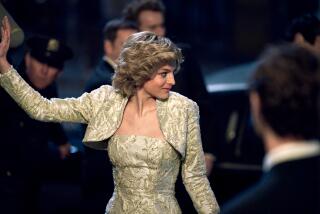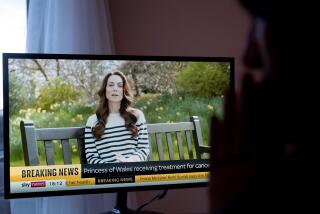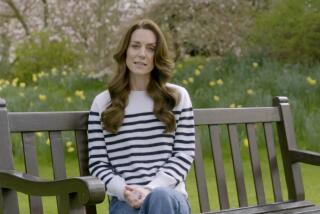Princess Diana Brought Home to Grieving Nation
- Share via
LONDON — Princess Diana, perhaps the world’s best-loved woman, came home to Britain on Sunday in a casket from a lovers’ holiday, welcomed by a nation grieving the loss of its “people’s princess.”
From across Britain, across France where she died and across the world came tears and tributes Sunday for the tall, willowy blond who touched the hearts of millions but never found lasting happiness herself.
With the pain came anger at the international press corps, particularly the freelance photographers who hounded Diana and were pursuing her car when it crashed in Paris early Sunday morning, killing the princess; her companion, Harrods heir Dodi Fayed; and their driver. A British bodyguard survived with serious injuries.
“Bastards!” a middle-aged mourner screamed at photographers outside Buckingham Palace on Sunday morning. But commentators sensed guilt too, as people wondered if a nation’s obsession with Diana also had contributed to her untimely death at age 36.
“I always believed the press would kill her in the end. But not even I could imagine that they would take such a direct hand in her death as seems to be the case,” Diana’s brother, Charles Spencer, said in a statement he read to reporters in South Africa, where he lives.
French police were questioning seven photographers who were chasing the car carrying Diana and Fayed, scion of Egyptian billionaire Mohammed Fayed, when it crashed in a tunnel near the River Seine in Paris.
Amid the tumult, the princess’ body was returned in eerie silence to a Royal Air Force base outside London. Not a public word was spoken as an honor guard unloaded the casket draped in the red-and-gold royal standard and slowly marched it to a waiting hearse in the late afternoon sunshine.
Prince Charles, Diana’s former husband and Britain’s heir to the throne, stood at attention alongside Prime Minister Tony Blair as mute symbols of a country grappling to accept Diana’s passing.
Earlier, Charles had flown to Paris to collect the body. Charles, accompanied by Diana’s two sisters, went to the hospital with French President Jacques Chirac to thank doctors there for their efforts in trying to save the princess.
In Scotland, locals and tourists silently lined narrow lanes outside Balmoral Castle, where Queen Elizabeth II consoled her grandsons, Prince William and Prince Harry. Diana was to have returned to London on Sunday to be with her sons during the last few days of their summer vacation.
Instead, the boys attended services at a small country church with their father, along with the black-clad queen and her husband, Prince Philip.
Officials at Buckingham Palace conferred with government ministers Sunday to arrange the princess’ funeral later this week. Details will be announced today, the palace said. To be answered is whether Diana, not technically a member of the royal family since her divorce, should nevertheless receive a state funeral. It was a decision that rested with the royal family Sunday night.
Fayed was buried in the southern English town of Woking on Sunday evening, police said. A police spokesman said: “The service is being conducted now at a cemetery in Woking. The family have insisted that it is private, and we are respecting their wishes.”
Dazed Mourners Outside Palaces
Outside Buckingham Palace, thousands milled in shock, some with flowers picked from neighboring parks. Long lines of mourners, many seeming dazed, filed past Diana’s home, Kensington Palace, trailing tears, flowers and anguish.
“Diana, you are the queen of our hearts,” read one card, echoing the princess herself, who once said that was her greatest ambition.
On Sunday, traditional British reserve cracked. Comfort-seeking strangers embraced in Diana’s honor. Buckingham Palace opened a condolence page on its Web site: https://www.royal.gov.uk
No corner of the kingdom was untouched, from the heart of England to the hills of Wales and the highlands of Scotland. Flags flew at half-staff. The BBC scrapped its scheduled programming, offering hymns and news in its stead.
A hastily arranged service at St. Paul’s Cathedral, where Charles and Diana married in 1981, drew 2,000 mourners from all faiths. At Harrods, London’s famous department store, the company’s green-and-gold flag, usually flanked by the flags of world nations, waved alone at half-staff in a gentle breeze on a sad and bewildering Sunday for Britain.
“I feel like everyone else in this country today. I am utterly devastated,” said Blair, the prime minister, fighting back tears. “She was the people’s princess, and that is how she will remain in our hearts and our memories forever.”
‘We Could Not Revive Her’
Diana reportedly never regained consciousness after the crash, which came as she and Fayed were apparently en route to one of the Fayed family’s apartments after dining at the Hotel Ritz, which is owned by the family.
Despite extensive surgery, “we could not revive her,” said Dr. Bruno Riou, anesthesiologist at La Pitie-Salpetriere hospital.
He said Diana had quickly gone into cardiac arrest and that doctors had tried to save her for at least two hours with internal and external cardiac massage.
Buckingham Palace said Charles informed William and Harry of their mother’s death before dawn Sunday at Balmoral, where the royal family traditionally spends the summer holidays. The queen and Charles were “deeply shocked and distressed by this terrible news,” a Buckingham Palace statement said.
The duchess of York, the former Sarah Ferguson and Diana’s former sister-in-law, said Sunday she had lost someone she has always considered a sister and a best friend.
“There are no words strong enough to describe the pain in her heart,” a statement said.
Diana had repeatedly railed against the photographers who dogged her steps, telling the French newspaper Le Monde in an interview printed last week that she would have left Britain to escape them except for her sons.
Declining to Buy Photos of Crash
The sensationalist British tabloid News of the World, a steady market for the paparazzi, said it had declined to buy pictures of the crash.
“Last night, a French photographer tried to sell pictures of Diana lying in the car for 200,000 pounds [about $325,000]. The News of the World refused,” the paper averred.
Diana had been circumspect about any relations with men since her divorce from Charles last year but apparently believed that the affection that had developed between her and Fayed over the summer was too good to hide.
The couple vacationed together on yachts and at well-exposed Mediterranean resorts three times in the past five weeks, triggering speculation that they would announce their engagement.
Freelance photographers and their reporter cousins never let up on the pair. “A Story of Love,” trumpeted the magazine of the Sunday Mirror being distributed around Britain even as the princess lay dying.
“After her cheerless marriage, what better than a hotblooded Mediterranean man?” the newspaper asked in the article accompanying grainy long-distance shots of Diana and Fayed embracing. News of her death did not reach Britain until near dawn on Sunday, but most British newspapers published late editions. “Diana Is Dead,” said the Sunday Mail in its black-bordered front page.
As calls sounded Sunday for stronger privacy laws in Britain, Diana’s brother said what many people were thinking.
“It would appear that every proprietor and editor of every publication that has paid for intrusive and exploitative photographs of her, encouraging greedy and ruthless individuals to risk everything in pursuit of Diana’s image, has blood on their hands,” Spencer said from Cape Town, South Africa, where he lives partly to avoid the probing lenses of paparazzi.
In a television interview in 1995, Diana complained that “I never know where a lens is going to be. On a normal day I’ll be followed by four cars. On a normal day I’ll come back to my car and find six freelance photographers jumping around me.”
‘Performance’ for the Photographers
As much as she hated the intrusion, Diana also was expert at using the press and paparazzi to her own advantage, the Daily Mirror newspaper’s veteran royal watcher, James Whitaker, told the BBC. Again and again in recent weeks, Diana allowed herself to be photographed at length in the south of France with Fayed.
“She walked on the beach, she stood talking to people, she got on a jet ski, she got on a motorboat. Why shouldn’t she do this? I’m not saying she shouldn’t. But that was definitely a virtuoso performance for us to get photographs and a story,” Whitaker said.
The result of one unannounced photo opportunity, as Diana must have known, was front-page coverage in the next day’s newspapers--not coincidentally the same day Charles threw a birthday party for his mistress, Camilla Parker-Bowles.
Still, it was in her self-assigned official roles as spokeswoman and lobbyist for the sick, the dying and the poverty-stricken that Diana was most familiar and most at home.
“She was a wonderful and warm human being, although her own life was often touched by tragedy. She touched the lives of so many others in Britain and throughout the world with joy and comfort,” said British leader Blair.
Describing himself as “profoundly saddened,” President Clinton offered his condolences to the British people in a brief message repeatedly shown here on television Sunday.
“Hillary and I knew Princess Diana, and we were very fond of her. We are profoundly saddened by this tragic event. Our thoughts and prayers tonight are with her family, friends and especially her children,” Clinton said.
Chirac, the French president, characterized Diana as a “young woman of our times, warm, full of life and generosity. Her tragic death will be deeply felt because she was a familiar figure to everyone.”
Diana’s work--and her appeal--cut across continents and social classes. In Calcutta on Sunday, Mother Teresa said she and the nuns of her Missionaries of Charity religious order were praying for Britain’s dead princess.
More to Read
Sign up for Essential California
The most important California stories and recommendations in your inbox every morning.
You may occasionally receive promotional content from the Los Angeles Times.










